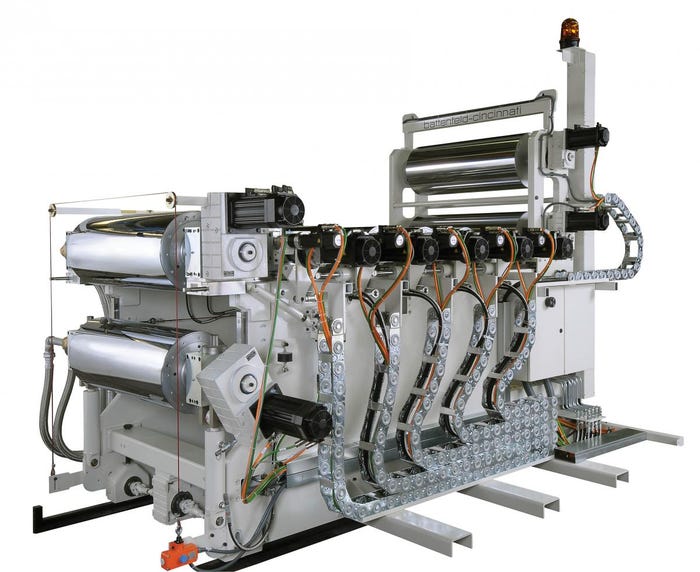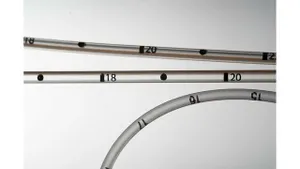K 2013: battenfeld-cincinnati touts energy-efficient machines for packaging
Düsseldorf, Germany—K 2010 was a pretty significant show for battenfeld-cincinnati. Created in April 2010, a few months before the international trade fair, the formal combination of Battenfeld Extrusionstechnik GmbH (Bad Oeynhausen, Germany) and Cincinnati Extrusion GmbH (Vienna, Austria), was divided into three divisions—construction, infrastructure, and packaging—that supply extrusion equipment for pipes, profiles, film, and sheet.
July 9, 2013
Düsseldorf, Germany—K 2010 was a pretty significant show for battenfeld-cincinnati. Created in April 2010, a few months before the international trade fair, the formal combination of Battenfeld Extrusionstechnik GmbH (Bad Oeynhausen, Germany) and Cincinnati Extrusion GmbH (Vienna, Austria), was divided into three divisions—construction, infrastructure, and packaging—that supply extrusion equipment for pipes, profiles, film, and sheet.
Now three years later, and with another K on the horizon, the Bad Oeynhausen/Vienna-based company is placing a greater emphasis on "green" technology.
"The merger of the two companies and consequently, uniformity in their product range as well as processes and IT concepts, has been implemented successfully and effectively," said Jürgen Arnold, CEO of battenfeld-cincinnati. "As a result, the entire product portfolio is no more than three years old, and since both companies have been concentrating on energy efficiency and saving resources since the middle of 2000, the machine solutions are the state of the art today in terms of energy and water consumption, as well as material savings."
At the K 2013 preview (July 1-3; Düsseldorf, Germany), battenfeld-cincinnati talked about its involvement in the VDMA's (Germany Engineering Federation) sustainability initiative, Blue Competence, which focuses on protecting the environment through innovative technologies and conserving resources.
According to the VDMA, Blue Competence has defined credible and resilient sustainable criteria and standards, which must be met by all those who join the initiative. Standards include: the partner has defined goals for its products and staff, which include sustainable practices; the partner offers services that feature professional guidance for energy efficiency and preservation of resources; the partner agrees to declare the sustainable activities of his company/products with at least one case for quantification; and the partner has implemented a management system.
"Our extruders and extrusion lines thus fit in with the VDMA's sustainability initiative," Arnold said. "battenfeld-cincinnati has not only involved its suppliers in these processes, but also optimized its production plants to save energy and materials. With our extrusion equipment, we offer the platform for saving resources in production and consequently for our customers' competitiveness."
To support the sustainability claim, battenfeld-cincinnati's three divisions will present extrusion solutions that operate energy-efficiently and also save material at K 2013. battenfeld-cincinnati touts its customer support that is focused on the cost and benefit value for the entire life cycle of the equipment. In addition, battenfeld-cincinnati places special emphasis on upgrading extrusion equipment by optimizing energy consumption and improving anti-wear protection to ensure consistent performance.
Packaging market
Henning Stieglitz, division manager for battenfeld-cincinnati packaging, said for the past few three years, the packaging division has concentrated on conserving resources.
He said the film packaging industry is booming, therefore film producers are increasingly demanding high-performance equipment to produce premium-quality film with low energy consumption.
At K 2010, battenfeld-cincinnati showcased its complete extruder series for cost-efficient and flexible direct extrusion of polyethylene terephthalate (PET) film. The first extruder of this series-a 1-120-34 D/V single-screw line with a modified planetary section-debuted at K 2007. battenfeld-cincinnati said it was responding to the booming PET film market by launching a complete machine series at K 2010. The series consisted of three machine models, with outputs ranging from 600 to 1200 kg/hr.
"Our focus is on PET for sure, but there has also been a strong tendency for PP, especially in North America, so we do expect growth with our machines," Stieglitz said.
 At this year's K, the company's packaging division will inform visitors about its high-speed extruder and new "Multi-Touch" roll stack, which can be delivered either as individual components or combined and integrated in complete extrusion lines.
At this year's K, the company's packaging division will inform visitors about its high-speed extruder and new "Multi-Touch" roll stack, which can be delivered either as individual components or combined and integrated in complete extrusion lines.
Stieglitz said they are quite optimistic about the future of the new development for the Multi-Touch roll stock.
In contrast to conventional 3-roll roll stacks, the Multi-Touch roll stack operates with a larger number of roll nips, thus achieving reliable cooling of the film on both sides. The new roll stack is equipped with a two-roll roll stack for preliminary calibration and three, five or seven rolls for final calibration. The first rolls come with a larger diameter to minimize deflection. The rolls that follow are smaller. This ensures the production of film with low tension and perfect flatness.
Due to continuous roll contact, the company said the film has hardly any orientation and an extremely even thickness profile. In contrast to standard roll stacks, where film tolerance margins of 3% are the order of the day, Multi-Touch achieves an accuracy of +/- 1%.
The company states that the material savings not only help to cut costs, but also make an active contribution to protecting the environment. This also applies to the use of thin-walled rolls in final calibration, which can be operated more energy-efficiently with the same hardness and equally high line loads.
Film can be produced with the new Multi-Touch roll stack at high line speeds from a great variety of materials such as PS, PET, PP or EVA and co-extruded products.
The high-speed single-screw extruder on display at K with a screw diameter of 75 mm and a 40 D processing length requires up to 25% less energy compared to a conventional extruder with equal performance. This extruder also ensures optimal melt attributes in the production of film from a great variety of materials, including PS, PET, PP and EVA and coextruded products. The processing machine reaches outputs of up to 2000 kg/h with a minimal footprint.
With all of its other machine concepts, the packaging division also targets resource-saving solutions. For example, battenfeld-cincinnati has developed a new anti-wear concept for planetary roller extruders, which are being used for applications such as calender feeding and pelletizing. With the new L+ planetary spindles, uptime can be increased by 30 to 50%, which also leads to a reduction in steel consumption and workloads.
For the PET industry, battenfeld-cincinnati will showcase its specialized single-screw extruder with an integrated compounding section for outputs between 500 and 1000 kg/h. With this extruder, up to 16% of energy costs can be saved by processing undried PET and thus dispensing with preliminary material drying.
The division is also presenting a project in the area of plastics recycling. Over the last few months, the existing granulating extruder series has been completely revised. In addition to the extruders, which were mainly energy-optimized, special attention was paid to the downstream equipment. Here modules have been created which optimally match the lines' performance range.
About the Author(s)
You May Also Like


